American nuclear arsenal
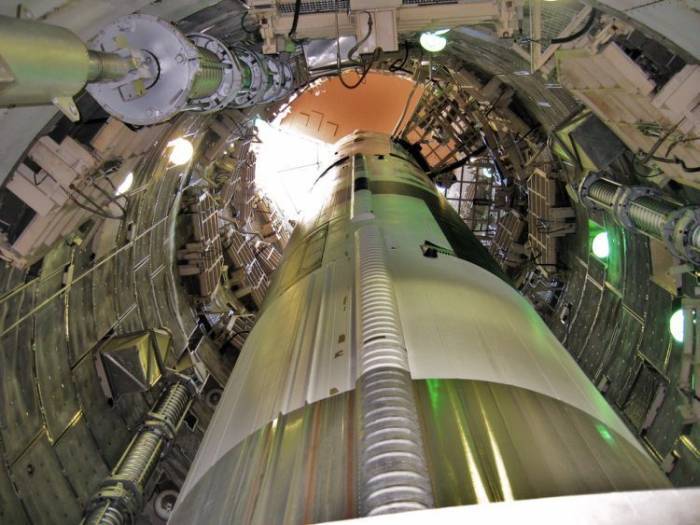
Every year the systems mounted here more and more resemble museum exhibits. Upstairs are all new international treaties under which these wells close one by one. But every day, the next crews of the US Air Force descend into concrete dungeons in anticipation of what absolutely should not happen ...
An inconspicuous ranch about fifteen from the bumpy two-lane road southeast of Great Falls, Montana. A primitive one-story building, a chain fence, an in-house garage and a basketball backboard directly above the driveway.
However, if you look more closely, you can note some funny details - a red-white lattice tower of a microwave radio relay rises above the buildings, here’s a helipad landing pad on the front lawn plus one more conical antenna of the decimeter range, protruding on the lawn like a white fungus. One might think that some university agricultural laboratory had settled here, or, say, a weather station — only the red banner on the fence confused notifying that everyone who tried to penetrate the territory without permission would be met with a fire of defeat.
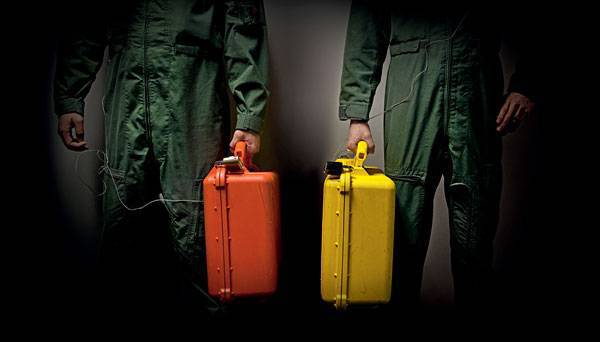
Another day of service
Another watch carries suitcases with secret documentation, fastened with steel cables to overalls. People will descend into the bunker on the 24-hour watch, taking control of the ballistic missiles hidden under the meadows of Montana. If a fatal order comes, these young Air Force officers will not hesitate to activate their apocalyptic weapon.
Inside the building, the security service scrupulously examines each incoming. The slightest suspicion - and in the room immediately appear guards with M4 carbines and handcuffs. The massive entrance door moves vertically upwards - so even winter snow drifts will not block it.
After the checkpoint, the interior becomes the same as in an ordinary barracks. In the center there is something like a mess room - a TV, sofas with armchairs and several long tables for common meals. Further from the hall there are exits to the cabins with bunk beds. Standard government posters of stupid talkers and omnipresent spies are hung on the walls.
One of the armored doors in the residential area leads to a small side room. Here sits the dispatcher responsible for security (Flight Security Controller, FSC), a non-commissioned officer, the commander of the protection of the launcher. The three-meter chest next to it is crammed with M4 and M9 carbines. There is one more door in this arsenal, in which neither the dispatcher nor the guards should enter in any way, unless this is required by an emergency situation. Behind this door there is an elevator, which, without stopping, goes straight down six floors to the ground.
In a calm voice, FSC telephones the elevator call. The elevator will not rise until all passengers leave it and the front door in the security room is locked. The steel door of the elevator is opened manually, in much the same way as the louvers are rolled up, which in small shops protect windows and doors for the night. Behind it is a small cabin with metal walls.
In order to go down to the 22 m under the ground, we will need less than a minute, but there, at the bottom of the hole, a completely different world will open up before us. The elevator door is built into the smoothly curving black wall of the round hall. Thick columns of shock absorbers were installed along the wall, breaking its monotony, which should absorb a shock wave if a nuclear warhead explodes somewhere nearby.
Behind the walls of the hall, something rumbled and clanged exactly as the elevating gates of the ancient castle should clang, after which the massive hatch gently leaned out, the 26-year-old Air Force captain Chad Diterle was holding the metal handle. Along the perimeter of this shockproof plug, which is a good one and a half meters thick, there are stencilled letters INDIA. The 24-hour watch carried by Dieterle, Launch Control Center (LCC) India, commander of the launch control center, has just come to the middle, and this launch position was organized here, on the Malmstrom Air Force base, even when the parents of this brave Air Force captain went to school.
LCC India is connected by cables to fifty hundred other mines scattered over an 10-kilometer radius. Each mine has one 18-meter intercontinental ballistic missile (ICBM) Minuteman III.
The Air Force Command refuses to report the number of warheads on each rocket, but it is known that there are no more than three of them. Each of the heads can destroy all life in a radius of a dozen kilometers.
After receiving the appropriate order, after half an hour, Diterle with his assistants can send this weapon to any part of the globe. Hiding in silence under the ground, he turns an inconspicuous ranch, lost in the open spaces of Montana, into one of the most strategic points of the planet.
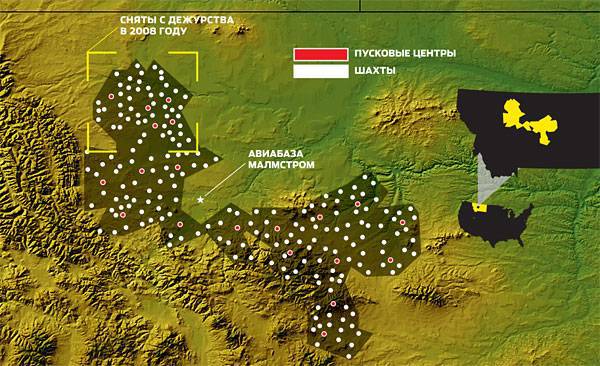
The US Air Force Base Malmstrom controls the 15 launchers and 150 mines. Her entire farm is spread over 35000 sq. Km. Bunkers with control panels were buried so deeply and scattered so far apart to survive a nuclear attack from the Soviet Union and to preserve the possibility of a nuclear retaliatory strike. To disable such a system, the warheads must get into each starting position without a miss.
Little but effective
The US nuclear arsenal is about 2200 strategic warheads that can be delivered using 94 bombers, 14 submarines and 450 ballistic missiles, and remains the basis of the entire national security system. Barack Obama does not get tired to declare his desire for a world completely free of nuclear weapons, but this does not contradict the fact that his administration is unequivocally stating with regard to nuclear policy: “As long as there are stocks of nuclear weapons in the world, the United States will maintain its nuclear forces in full and effective combat readiness. "
Since the cold war ended, the total number of nuclear warheads in the world has radically decreased. True, now states such as China, Iran or North Korea are deploying their nuclear programs and constructing their own long-range ballistic missiles. Therefore, despite the stilted rhetoric and even sincere good intentions, it is not for America to part with its nuclear ammunition, as well as with airplanes, submarines and missiles that could deliver it to the target.
The missile component of the American nuclear triad has been in existence for 50 for years, but year after year it has become the focus of intense discussions between Moscow and Washington. Last year, the Obama administration signed a new treaty with Russia on measures to further reduce and limit strategic offensive arms - START III. As a result, the nuclear arsenals of these two countries should be limited to quantities of less than 1550 strategic warheads for a seven-year period. Only 450 will remain from 30 American missiles on duty. In order not to lose support from the “hawks” and merely skeptical senators, the White House proposed adding $ 85 billion to upgrade the remaining nuclear forces over the next ten years (this amount must be approved at the next meeting of Congress). “I will vote for the ratification of this treaty ... since our president clearly intends to ensure that the remaining weapons are truly effective,” said Tennessee senator Lamar Alexander.
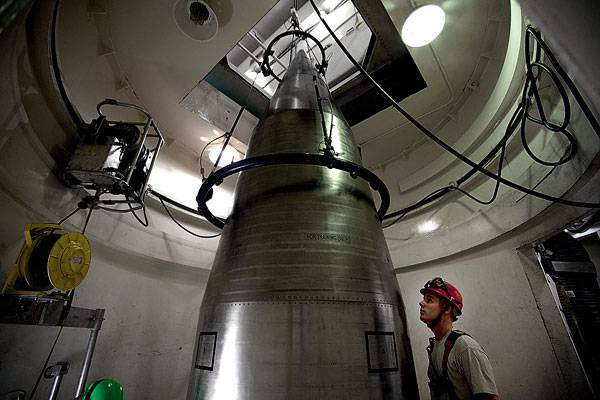
Thousands of officers at the bases of the US Air Force support mine launchers in combat readiness. Since 2000, the Pentagon has spent more than $ 7 billion on upgrading this kind of troops. All work was aimed at ensuring that the Minuteman III model successfully reached the date of decommissioning, which was assigned to 2020 year, but last year the Obama administration extended the life of this series by another ten years.
Nuclear missile umbrella
So why are strategic missile forces, a symbol of the cold war ending, remaining at the center of the 21st century's defensive strategy, politics and diplomacy? If we take three types of delivery vehicles (airplanes, submarines and ballistic missiles), then intercontinental ballistic missiles remain the means of the most rapid response to aggression from the enemy, and indeed the most operational weapon, allowing a preventive strike. Submarines are good because they are practically invisible, nuclear bombers are capable of delivering precision point strikes, but only intercontinental missiles are always ready to deliver an irresistible nuclear strike to any point on the globe, and they can do it in a matter of minutes.
The American nuclear missile umbrella is now deployed over the whole world. "As representatives of the air force, we are convinced that America is obliged to keep at sight and under the threat of any enemy object, wherever it is, no matter how serious protection it covers, no matter how deep it is hidden," Lieutenant-General Frank Klotz, who only in January left the post of head of the Strategic strike command (Global Strike Command), a structure that manages nuclear bomber and ballistic missiles.
The starting positions of strategic missiles represent a major engineering achievement. All these mines were built at the beginning of the 1960's, and since then 99% of the time they have been on full alert. Even more interestingly, the Pentagon built these launch sites for only a few decades. When the MinutemanIII missiles are decommissioned, all mines and launchers at the Malmstrom base will be mothballed and buried for a period of 70 years.
So, the Air Force manages the most powerful weapons in the world, and the equipment for controlling these weapons was created in the space era, and not at all in the 21st century of information technology. Nevertheless, these old launch systems do their job much better than one might think. “To build such a system that will stand the test of time and will still act brilliantly,” says Klotz, “this is a true triumph of engineering genius. These guys in the 1960-x thought out every detail, generously laying a few redundant levels of reliability. "
Thousands of dedicated officers at three bases of the Air Force - Malmstrom, the base of them. F.E. Warren in Wyoming and Mino in North Dakota - do not spare the forces that the mine launchers remain in constant combat readiness.
The Minuteman III model was set up around the mines in the 1970's, and the date of its decommissioning was set to 2020 year, but last year the Obama administration extended the life of this series for another decade. In response to this demand, the leadership of the Air Force drew up a schedule for the reorganization of the existing missile bases. To this must go a tangible bit of the billions of dollars that were recently promised by the White House.
Norma - excellence
Back to the India Launch Center, hidden under an inconspicuous ranch. Since the reign of Kennedy, little has changed inside. Of course, paper teletype printers have given way to digital screens, and servers installed at the top provide an underground crew and Internet access, and even direct television when the situation is calm. However, the local electronics — hefty blocks inserted into wide metal racks and studded with lots of shining light bulbs and illuminated buttons — recalls the scenery from the first versions of the Star Trek television series. Something, in fact, literally asks for an antique shop. With a confused smile, Diterle pulls a nine-inch floppy disk out of the console - an element of the ancient, but still well-functioning Strategic System of Automatic Command and Control.

Mines were built on small plots bought out from the previous owners. You can freely moan along the fence, but if you just go behind it, the security service can open fire to kill.
The rockets themselves and the equipment installed at the ground level can still be somehow modernized, but with the underground mines and the starting centers themselves everything is much more complicated. But time does not spare them. It is very difficult to fight corrosion. Any ground movement can break the underground communication lines.
Launch Control Center India is one of the 15 centers at which Malmstrom’s air force missile basemen are on duty. “Take an ordinary house that has already defended its 40 years,” said Colonel Jeff Frankhauser, commander of the base maintenance team, “and bury it underground.” And then think about how you will repair everything there. This is the same situation with us. ”
This missile base includes 150 nuclear ballistic missiles scattered throughout the launch sites in 35000 km2 territory among the mountains, hills and plains of Montana. Due to the large distance between the mines of the USSR, it was not possible with one massive missile strike to destroy all launch positions and command posts, which guaranteed America the possibility of a retaliatory strike.
This elegant doctrine of mutual deterrence implied the obligatory existence of a developed infrastructure. In particular, all these mines and command posts are interconnected by hundreds of thousands of kilometers of underground cables. Fist-thick wiring harnesses are woven from hundreds of insulated copper wires and laid in shells, within which increased pressure is maintained. If the air pressure in the pipe drops, the team of operators concludes that a crack has formed somewhere in the containment shell.
The communication system that stretches across the surrounding expanses is a matter of constant concern for Malmstrom base personnel. Every day, hundreds of people — 30 teams on the control panels, 135 maintenance workers, and 206 security guards — enter the service, keeping the whole economy in order. Some command posts are three hours from the base. They are saddened by heroes offended by fate, who are called “Farsiders” at the base. Every day, jeeps, trucks and bulky self-propelled units to retrieve rockets from the ground are darting along the surrounding roads, and the total length of roads on this base is 40 000 km, and 6000 of them are primers, refined with gravel.
Here the slogan reigns: “Our norm is perfection,” and in order that no one would ever forget about this tough principle, a whole army of controllers look after the staff. Any mistake can lead to removal from duty until the violator re-passes the qualification exam. Such picky control applies to all services of the missile base.
The cook will receive a strict penalty from the officer for using expired sauce for the salad or not cleaning the hood over the stove in time. And this is correct - food poisoning can undermine the combat readiness of the launch platoon with the same success as a command of enemy special forces would have done. Caution to paranoid limits is a basic principle for all who serve on this base. “At first glance it may seem that we are being reinsured,” says Colonel Mohammed Khan (until the very end of 2010, he served as the Malmstrom base as commander of the 341 Rocket Division), “but look at this matter seriously, here we have real nuclear warheads ".
Weekdays bunker
To launch a nuclear ballistic missile, one turn of the key is not enough. If the corresponding command arrives at the India launch center, Diterle with his deputy, captain Ted Dzhivler, must verify the encryption sent from the White House with the cipher stored in the steel safes of the center.
Then each of them will take up his own triangular switch, with his eyes fixed on the electronic clock ticking between the blocks of electronic equipment. At a given moment, they should turn the knife switches from the “ready” position to the “start” position. At the same time, two missilemen on the other launcher will turn their switches - and only after that the ballistic missile will break free.
Each mine is suitable for only one launch. In the very first seconds, electronic components, ladders, communication cables, safety sensors and drainage pumps will burn out or melt in it. A cloud of smoke rises above the hills of Montana, ridiculously exactly repeating the outline of the mine mouth. Relying on a column of jet gases, the rocket will break out in a matter of minutes into open space. Another half an hour, and the warheads will begin to fall on their assigned targets.
The shock power of the weapons entrusted to these missilemen, and the entire measure of the responsibility assigned to them, are vividly emphasized by the harsh situation in the bunker. In the far corner is a simple mattress, fenced off with a black curtain so that the light does not hit in the eyes. “It’s not a great pleasure to wake up in this corner,” says Dieterle.
And it’s time for us to return to the world that rocket men call the "real". Dieterle pulls the handle of a black shockproof plug until it starts to turn smoothly. He smiles discreetly at parting, and the door slams shut behind us with a heavy thud. We are going up, and there, downstairs, Dieterle remains and the same as he is - in tense eternal waiting.
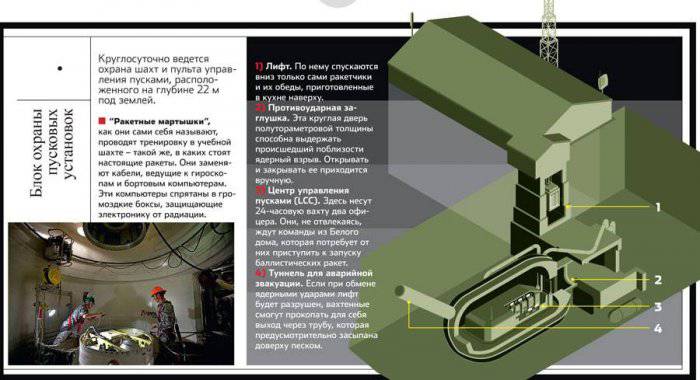
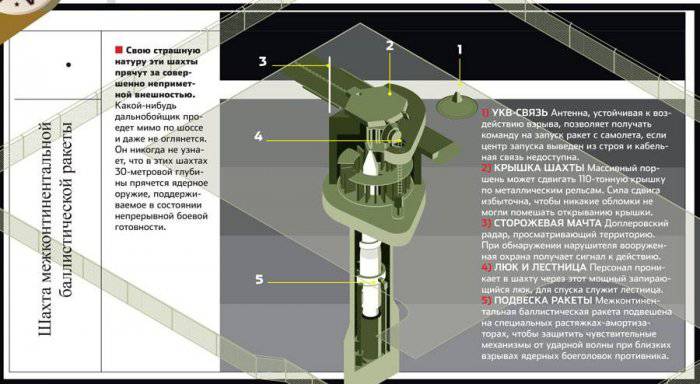
Information